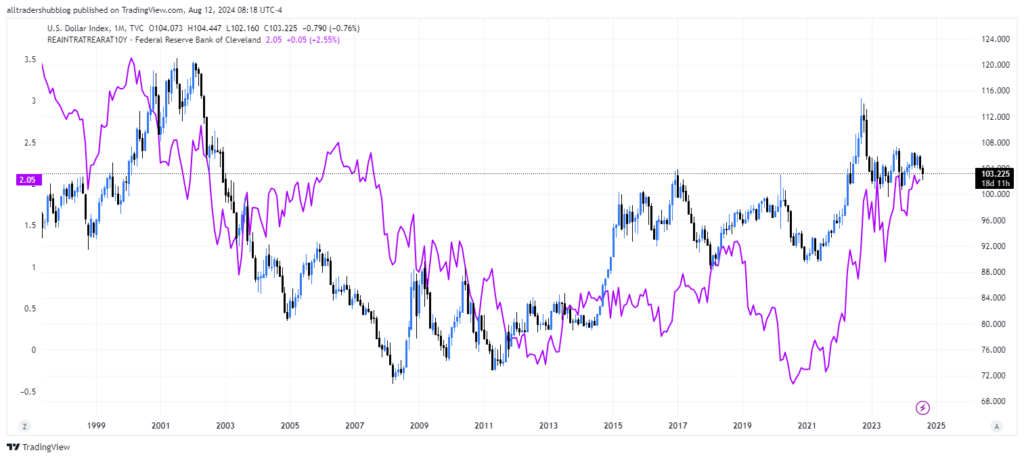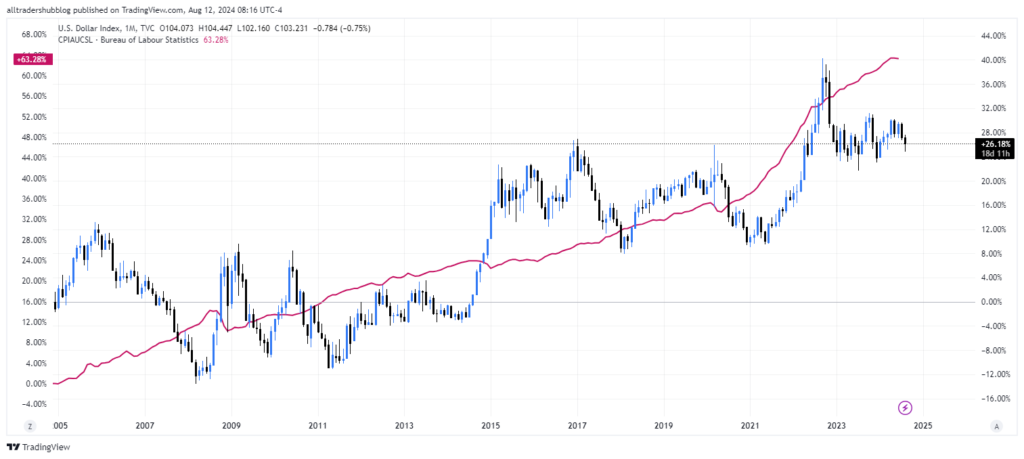Inflation is a critical economic indicator that plays a significant role in determining the value of a country’s currency. For forex traders, understanding how inflation influences currency strength is crucial for making informed trading decisions.
In this article, we’ll explore the relationship between inflation and currency strength, using the United States as a key example.
Definition of Inflation
Inflation refers to the rate at which the general level of prices for goods and services rises, eroding purchasing power over time.
Central banks, like the U.S. Federal Reserve, monitor inflation closely because stable inflation is vital for a healthy economy.
However, when inflation rises too quickly, it can have adverse effects, including diminishing the value of a currency.
How Inflation Affects Currency Strength
Purchasing Power Parity (PPP)
One of the primary ways inflation impacts currency strength is through the concept of Purchasing Power Parity (PPP). According to PPP, the exchange rate between two countries should adjust to reflect changes in price levels due to inflation. If a country experiences higher inflation than its trading partners, its currency should depreciate to restore balance in purchasing power.
For instance, if inflation in the U.S. is higher than in the Eurozone, the U.S. dollar (USD) might weaken against the Euro (EUR) because each dollar now buys fewer goods and services than before, while the Euro remains relatively stronger.
Interest Rates and Inflation
Central banks use interest rates as a tool to control inflation. When inflation rises, central banks may increase interest rates to cool down the economy. Higher interest rates typically attract foreign capital, leading to an appreciation of the currency.
Conversely, if inflation is low or falling, central banks may cut interest rates to stimulate economic growth. Lower interest rates can lead to a weaker currency because the returns on investments in that currency are less attractive to investors.
As of September 2024, the U.S. Federal Reserve is considering cutting interest rates due to moderating inflation and slowing economic activity. This potential rate cut could weaken the U.S. dollar, as lower rates make U.S. assets less attractive to foreign investors.

Investor Confidence and Inflation Expectations
Inflation can also impact currency strength through investor confidence. High inflation can lead to uncertainty about the future purchasing power of a currency, prompting investors to move their capital to more stable currencies. This shift can cause the currency of the high-inflation country to depreciate.
Inflation expectations are just as important as actual inflation. If investors believe inflation will rise, they might sell off the currency in anticipation of future depreciation, weakening the currency in the present.
Real vs. Nominal Interest Rates
It’s important to differentiate between nominal and real interest rates. Real interest rates are adjusted for inflation, and they provide a more accurate measure of the returns on investments. Even if nominal rates are high, if inflation is also high, the real interest rate may be low, making the currency less attractive.
If U.S. inflation is at 4% and the nominal interest rate is 3%, the real interest rate is -1%. This negative real rate can weaken the USD as investors seek better returns elsewhere.

U.S. Example: Inflation and the Dollar
The U.S. dollar’s strength or weakness is closely tied to inflation trends. For example, during periods of high inflation in the U.S., the dollar often weakens against other major currencies like the Euro, Yen, or Swiss Franc. This is because higher inflation erodes the purchasing power of the dollar, and if the Federal Reserve doesn’t raise interest rates sufficiently to combat inflation, the currency may continue to depreciate.
However, the Fed’s response to inflation is critical. In 2022-2023, the Fed aggressively raised interest rates to combat soaring inflation, which helped strengthen the dollar significantly. As inflation began to moderate in 2024, the Fed considered cutting rates, which created downward pressure on the dollar, reflecting the complex relationship between inflation, interest rates, and currency strength.

Conclusion
Inflation is a key determinant of currency strength in the forex market. Higher inflation generally leads to a weaker currency, unless countered by higher interest rates. For forex traders, keeping an eye on inflation trends and central bank responses is essential for predicting currency movements. By understanding the dynamics between inflation and currency strength, traders can better navigate the forex market and make more informed trading decisions.